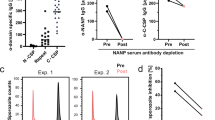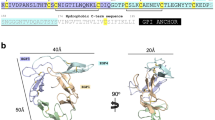Abstract
Parasite glycosylphosphatidylinositol (GPI) is an important toxin in malaria disease, and people living in malaria-endemic regions often produce high levels of anti-GPI antibodies. The natural anti-GPI antibody response needs to be understood to aid the design of an efficient carbohydrate-based antitoxin vaccine. We present a versatile approach based on a synthetic GPI glycan array to correlate anti-GPI antibody levels and protection from severe malaria.
This is a preview of subscription content, access via your institution
Access options
Subscribe to this journal
Receive 12 print issues and online access
$259.00 per year
only $21.58 per issue
Buy this article
- Purchase on Springer Link
- Instant access to full article PDF
Prices may be subject to local taxes which are calculated during checkout


Similar content being viewed by others
References
Gupta, S., Snow, R.W., Donnelly, C.A., Marsh, K. & Newbold, C. Nat. Med. 5, 340–343 (1999).
Schofield, L. & Grau, G.E. Nat. Rev. Immunol. 5, 722–735 (2005).
Almeida, I.C. et al. EMBO J. 19, 1476–1485 (2000).
Debierre-Grockiego, F. et al. J. Biol. Chem. 278, 32987–32993 (2003).
Boutlis, C.S. et al. Infect. Immun. 70, 5052–5057 (2002).
Gowda, D.C. & Davidson, E.A. Parasitol. Today 15, 147–152 (1999).
Singh, N., Liang, L.N., Tykocinski, M.L. & Tartakoff, A.M. J. Biol. Chem. 271, 12879–12884 (1996).
Naik, R.S. et al. J. Exp. Med. 192, 1563–1576 (2000).
de Souza, J.B. et al. Infect. Immun. 70, 5045–5051 (2002).
Suguitan, A.L., Jr . et al. Infect. Immun. 72, 5267–5273 (2004).
Schofield, L., Hewitt, M.C., Evans, K., Siomos, M.A. & Seeberger, P.H. Nature 418, 785–789 (2002).
Gerold, P., Dieckmann-Schuppert, A. & Schwarz, R.T. J. Biol. Chem. 269, 2597–2606 (1994).
Gerold, P., Schofield, L., Blackman, M.J., Holder, A.A. & Schwarz, R.T. Mol. Biochem. Parasitol. 75, 131–143 (1996).
Schmidt, A., Schwarz, R.T. & Gerold, P. Exp. Parasitol. 88, 95–102 (1998).
Borrow, R. et al. J. Infect. Dis. 184, 377–380 (2001).
Acknowledgements
We thank the Swiss National Science Foundation (SNF grant 205321-107651 to P.H.S. and 310000-116337/1 to G.P.), the ETH Zürich and the Fondation Bay for generous support of this research. A European Molecular Biology Organization long-term fellowship (to F.K.) is gratefully acknowledged. We thank J. Sobek for assistance in array printing.
Author information
Authors and Affiliations
Contributions
F.K., G.P. and P.H.S. designed the research. F.K., M.T. and X.L. performed the research. X.L., Y.-U.K. and F.T. contributed new reagents and analytic tools. F.K., M.T., G.P. and P.H.S. analyzed the data. F.K., M.T., X.L., G.P. and P.H.S. wrote the paper with contributions from the other authors.
Corresponding author
Supplementary information
Supplementary Text and Figures
Supplementary Figures 1–3 and Supplementary Methods (PDF 310 kb)
Rights and permissions
About this article
Cite this article
Kamena, F., Tamborrini, M., Liu, X. et al. Synthetic GPI array to study antitoxic malaria response. Nat Chem Biol 4, 238–240 (2008). https://doi.org/10.1038/nchembio.75
Received:
Accepted:
Published:
Issue Date:
DOI: https://doi.org/10.1038/nchembio.75
This article is cited by
-
In-depth analysis of the genome of Trypanosoma evansi, an etiologic agent of surra
Science China Life Sciences (2019)
-
IgG antibodies to synthetic GPI are biomarkers of immune-status to both Plasmodium falciparum and Plasmodium vivax malaria in young children
Malaria Journal (2017)
-
Viral glycoproteins: biological role and application in diagnosis
VirusDisease (2016)
-
Microbial glycan microarrays define key features of host-microbial interactions
Nature Chemical Biology (2014)



